Abstract
Although it has been established that environmental contaminants can alter immune function, the mechanisms of action have yet to be determined. This paper reviews the effects of hydrocarbon environmental contaminants on lymphocyte function and presents an approach which may serve to delineate the mechanisms of action. The approach is based on the use of the developmental phases of an immune response and assays which can be used for their functional assessment. Possible interactions between environmental contaminants and lymphocyte function and factors which must be considered in the evaluation of immune status are discussed. In addition, a study on the influence of the chronic exposure to two polyhalogenated hydrocarbons, PCB and HCB, on several parameters of lymphocyte function in mice is presented.
Full text
PDF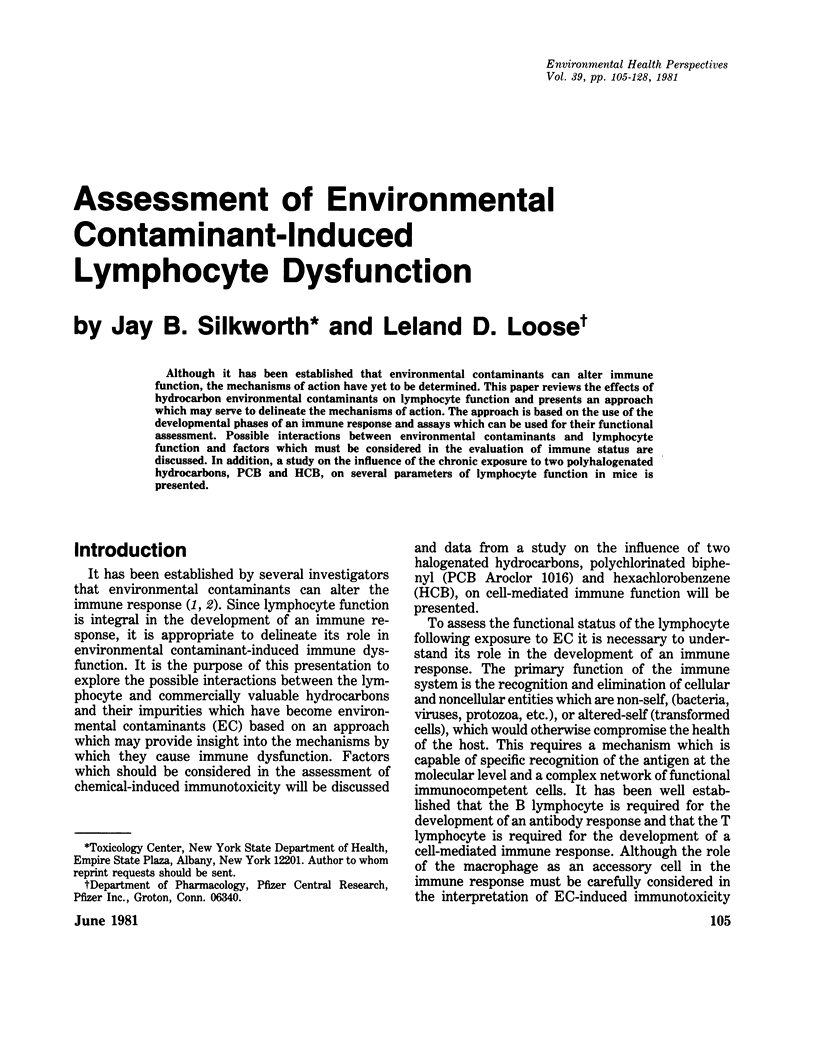
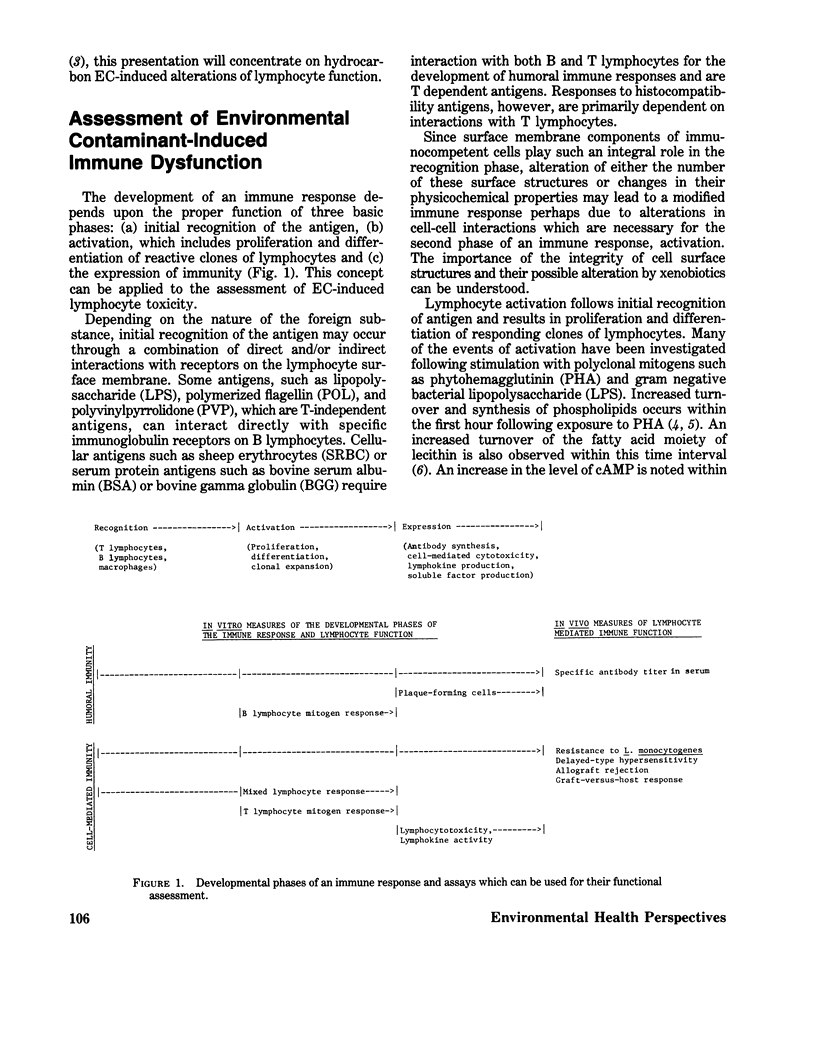


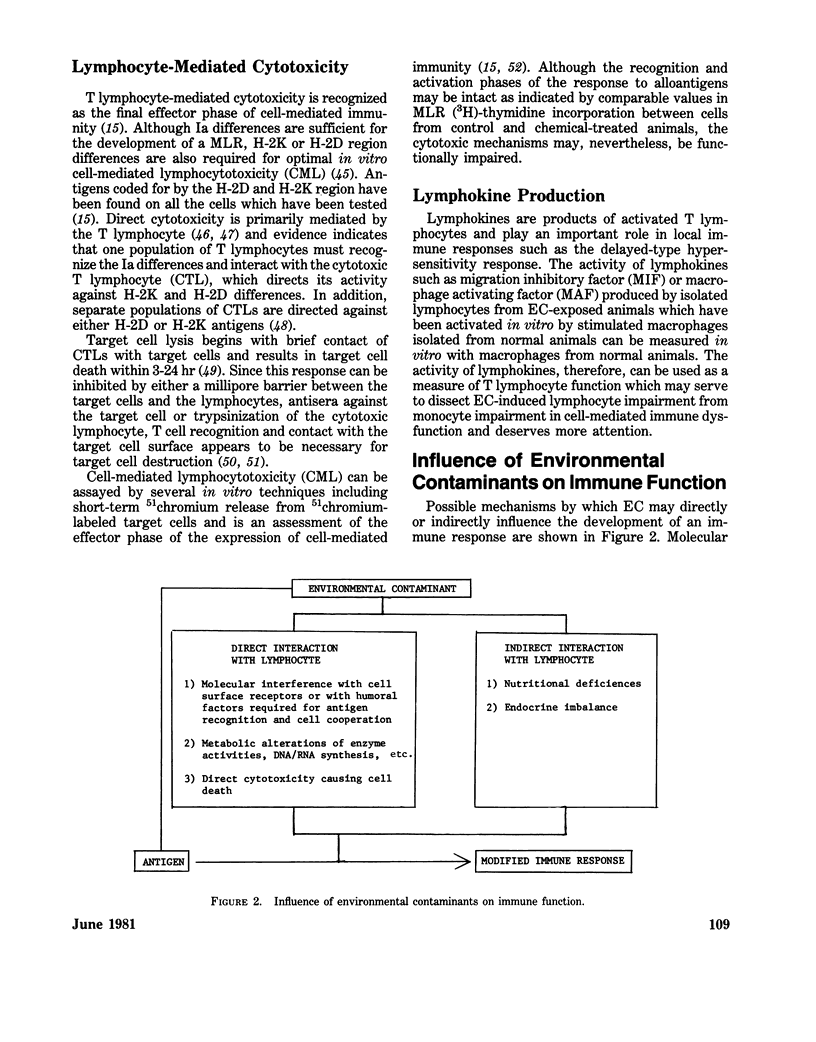
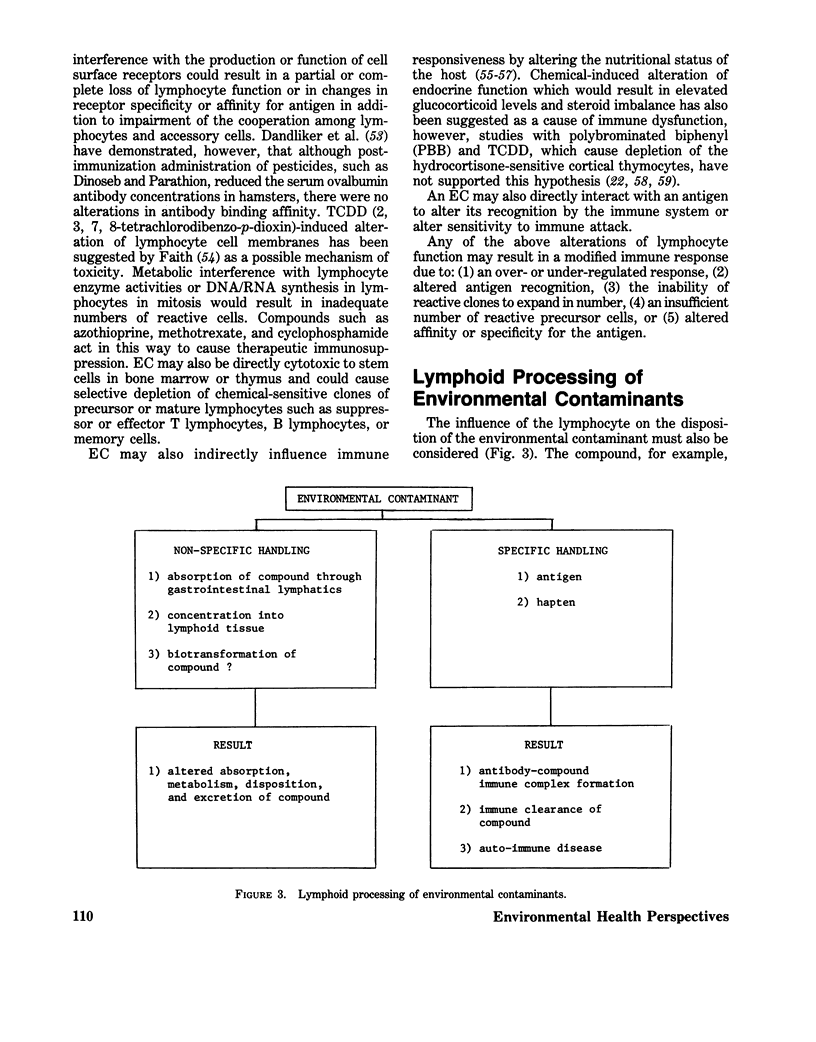
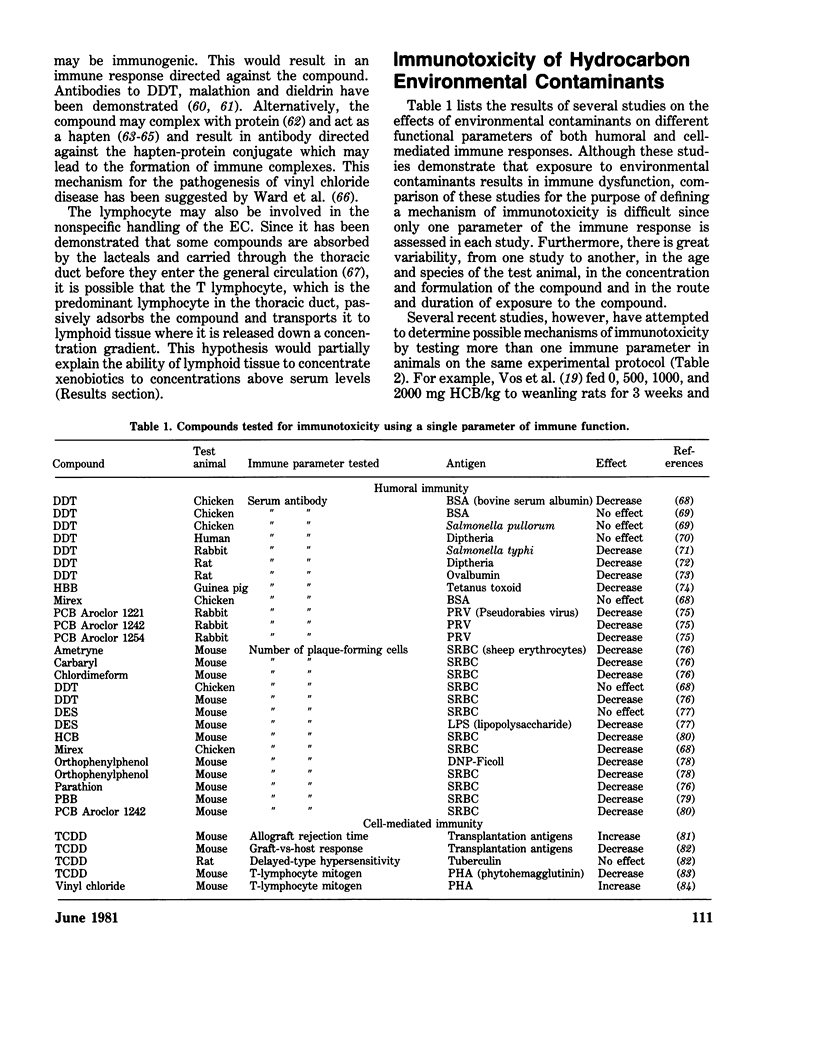

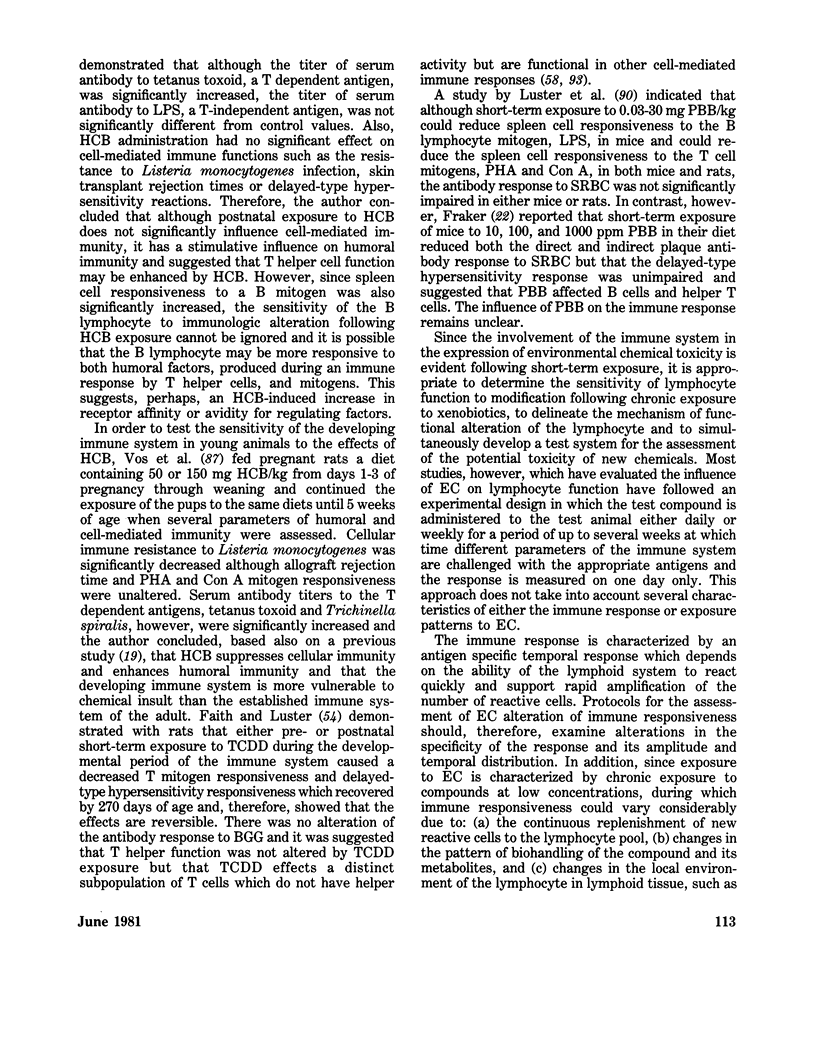
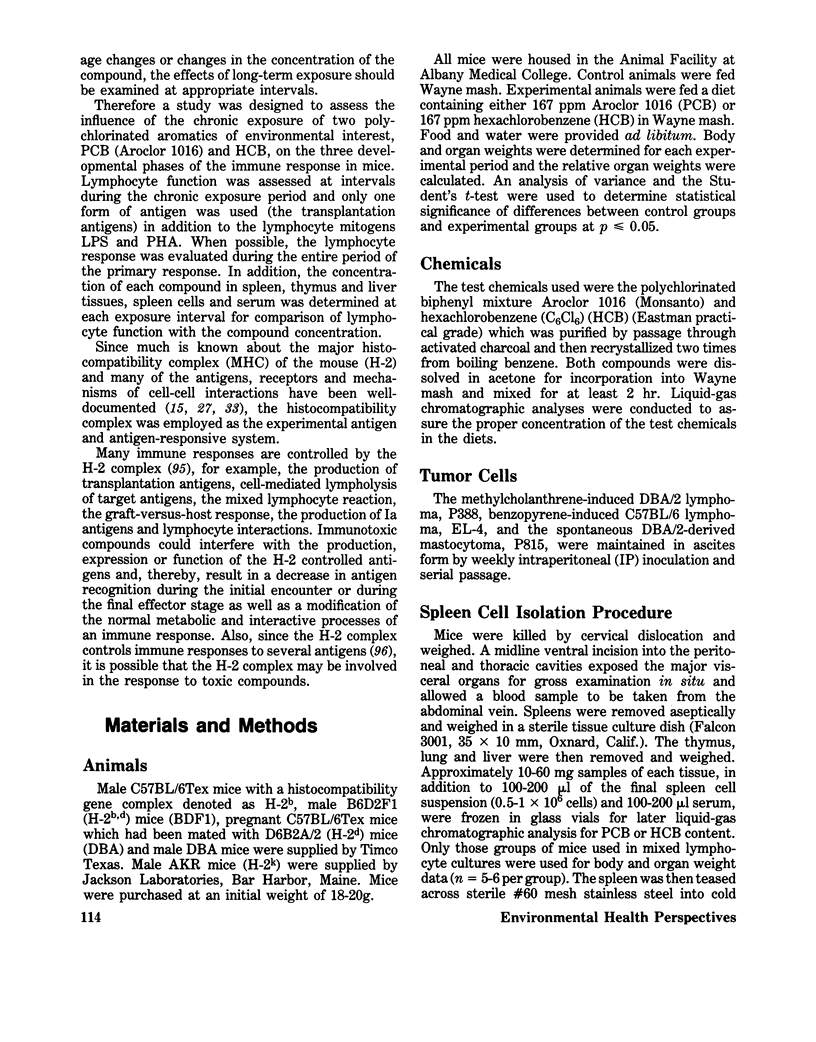

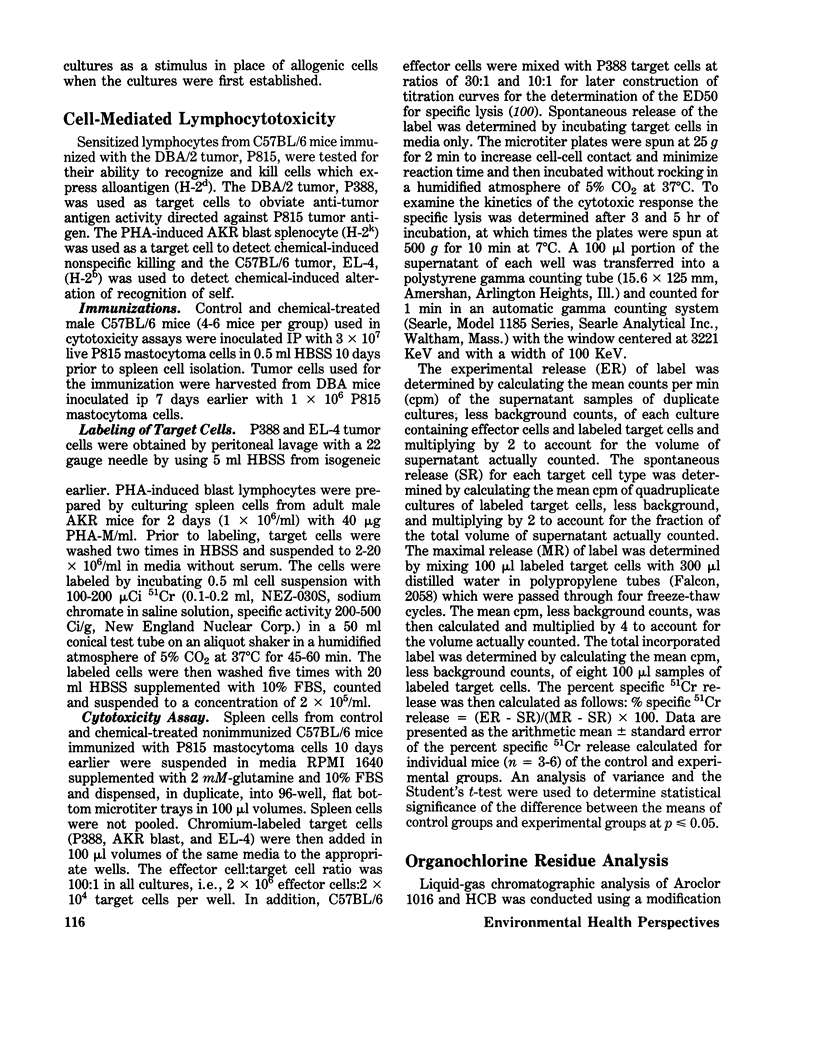

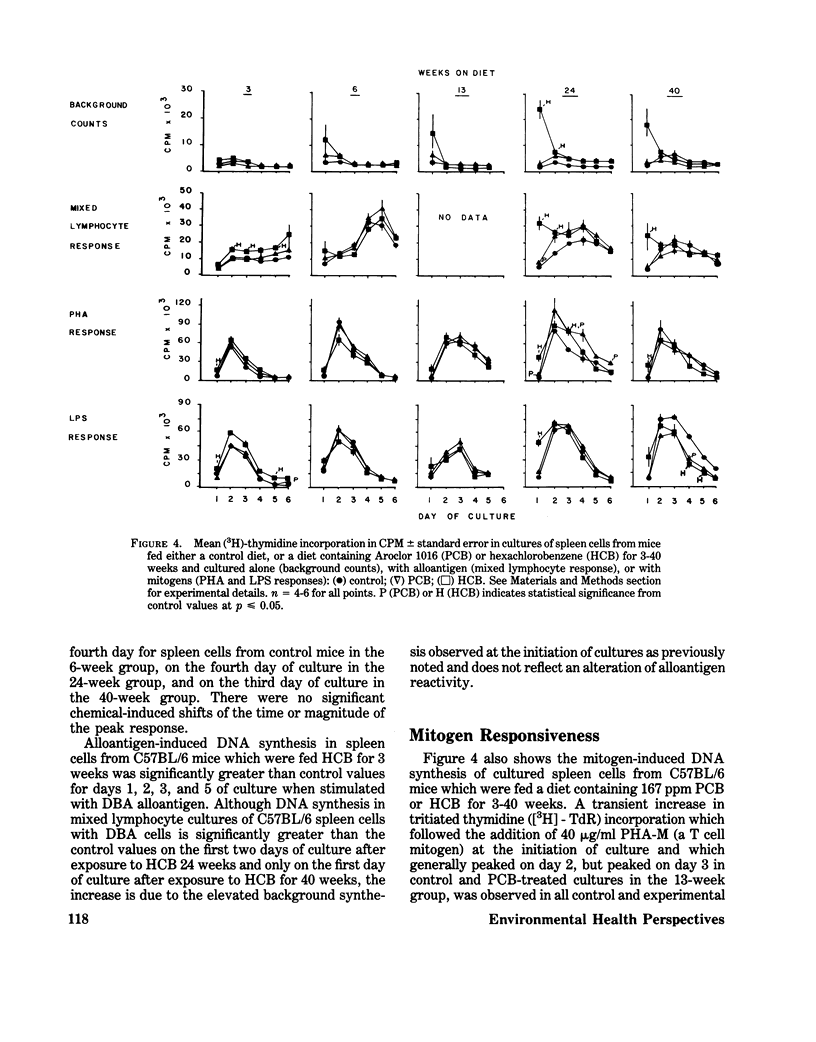

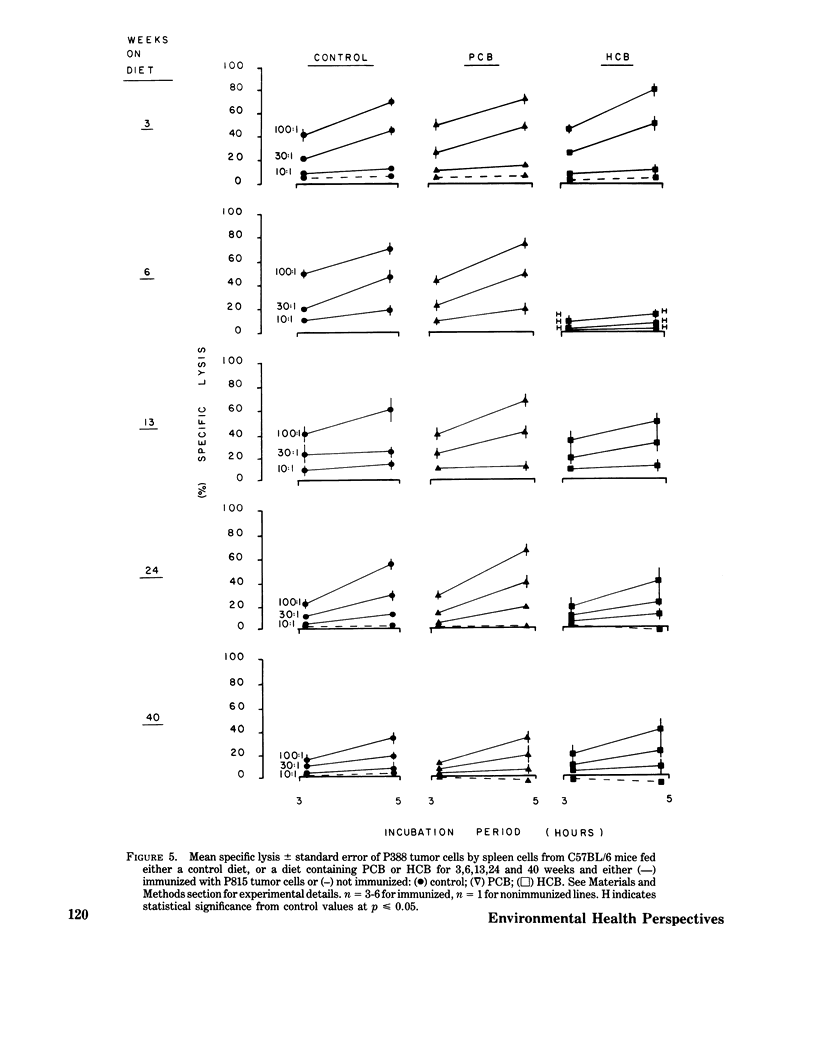

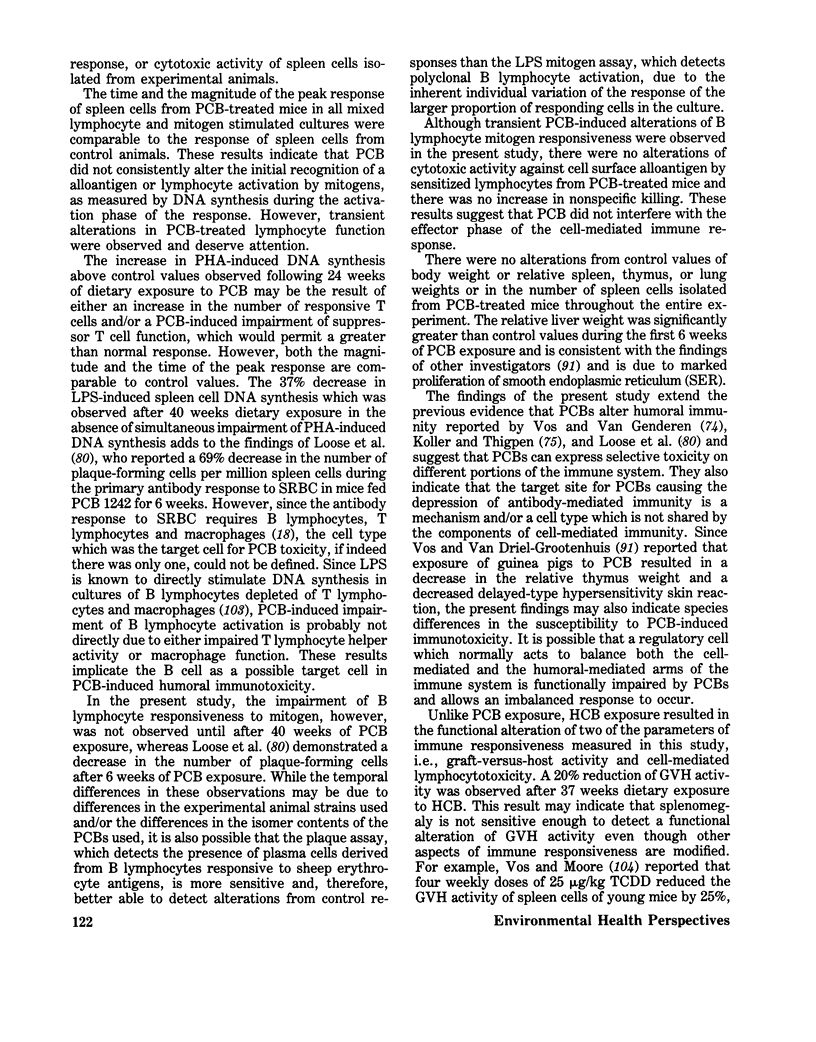


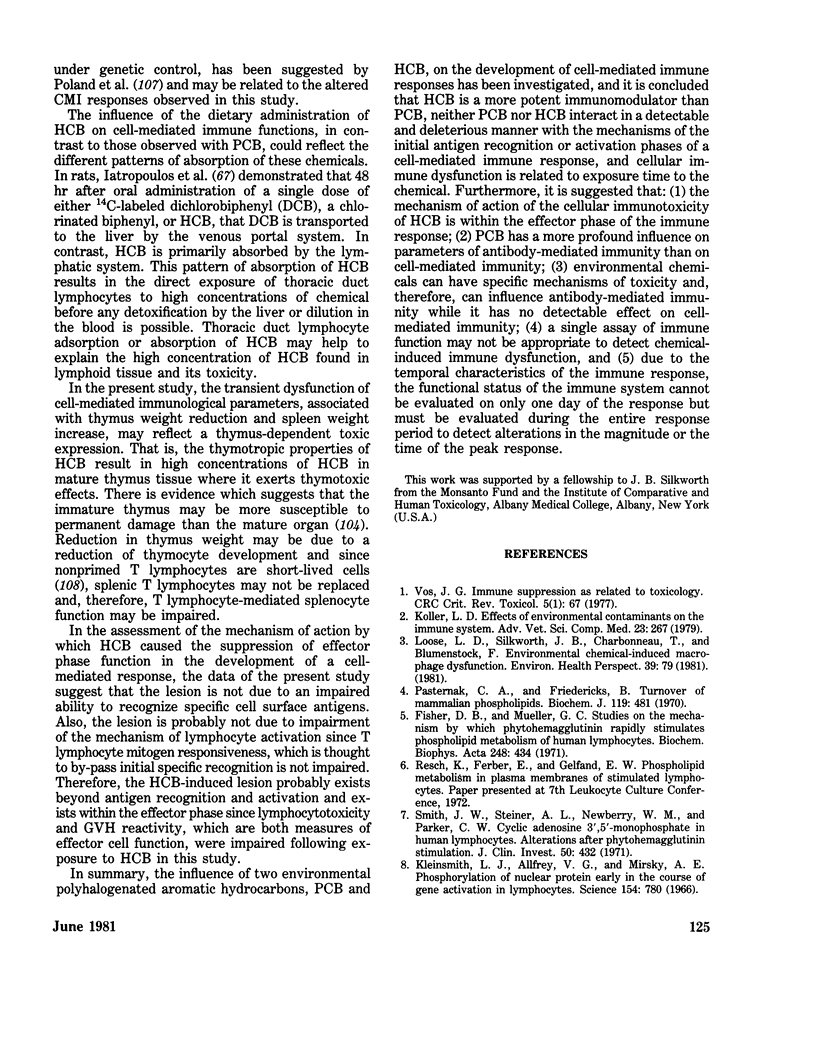


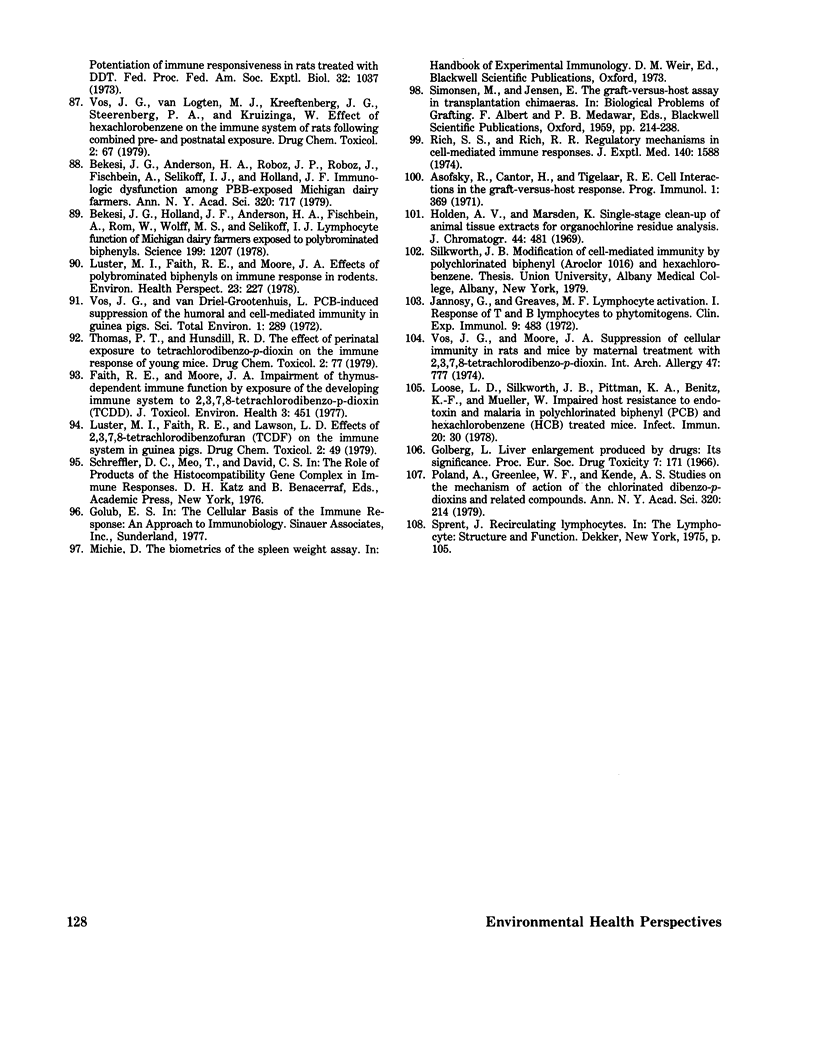
Selected References
These references are in PubMed. This may not be the complete list of references from this article.
- Albro P. W., Luster M. I., Chae K., Chaudhary S. K., Clark G., Lawson L. D., Corbett J. T., McKinney J. D. A radioimmunoassay for chlorinated dibenzo-p-dioxins. Toxicol Appl Pharmacol. 1979 Aug;50(1):137–146. doi: 10.1016/0041-008x(79)90501-5. [DOI] [PubMed] [Google Scholar]
- Alter B. J., Schendel D. J., Bach M. L., Bach F. H., Klein J., Stimpfling J. H. Cell-mediated lympholysis. Importance of serologically defined H-2 regions. J Exp Med. 1973 May 1;137(5):1303–1309. doi: 10.1084/jem.137.5.1303. [DOI] [PMC free article] [PubMed] [Google Scholar]
- Andersson L. C., Nordling S., Häyry P. Proliferation of B and T cells in mixed lymphocyte cultures. J Exp Med. 1973 Jul 1;138(1):324–329. doi: 10.1084/jem.138.1.324. [DOI] [PMC free article] [PubMed] [Google Scholar]
- Bach F. H., Bock H., Graupner K., Day E., Klostermann H. Cell kinetic studies in mixed leukocyte cultures: an in vitro model of homograft reactivity. Proc Natl Acad Sci U S A. 1969 Feb;62(2):377–384. doi: 10.1073/pnas.62.2.377. [DOI] [PMC free article] [PubMed] [Google Scholar]
- Bekesi J. G., Anderson H. A., Roboz J. P., Roboz J., Fischbein A., Selikoff I. J., Holland J. F. Immunologic dysfunction among PBB-exposed Michigan dairy farmers. Ann N Y Acad Sci. 1979 May 31;320:717–728. doi: 10.1111/j.1749-6632.1979.tb56646.x. [DOI] [PubMed] [Google Scholar]
- Bekesi J. G., Holland J. F., Anderson H. A., Fischbein A. S., Rom W., Wolff M. S., Selikoff I. J. Lymphocyte function of Michigan dairy farmers exposed to polybrominated biphenyls. Science. 1978 Mar 17;199(4334):1207–1209. doi: 10.1126/science.204005. [DOI] [PubMed] [Google Scholar]
- Benacerraf B., McDevitt H. O. Histocompatibility-linked immune response genes. Science. 1972 Jan 21;175(4019):273–279. doi: 10.1126/science.175.4019.273. [DOI] [PubMed] [Google Scholar]
- Bloom B. R., Bennett B. Mechanism of a reaction in vitro associated with delayed-type hypersensitivity. Science. 1966 Jul 1;153(3731):80–82. doi: 10.1126/science.153.3731.80. [DOI] [PubMed] [Google Scholar]
- Cantor H., Asofsky R. Synergy among lymphoid cells mediating the graft-versus-host response. II. Synergy in graft-versus-host reactions produced by Balb-c lymphoid cells of differing anatomic origin. J Exp Med. 1970 Feb;131(2):235–246. doi: 10.1084/jem.131.2.235. [DOI] [PMC free article] [PubMed] [Google Scholar]
- Cantor H. The effects of anti-theta antiserum upon graft-versus-host activity of spleen and lymph node cells. Cell Immunol. 1972 Mar;3(3):461–469. doi: 10.1016/0008-8749(72)90251-1. [DOI] [PubMed] [Google Scholar]
- Centeno E. R., Johnson W. J., Sehon A. H. Antibodies to two common pesticides, DDT and malathion. Int Arch Allergy Appl Immunol. 1970;37(1):1–13. doi: 10.1159/000230215. [DOI] [PubMed] [Google Scholar]
- Cerottini J. C., Nordin A. A., Brunner K. T. Cellular and humoral response to transplantation antigens. I. Development of alloantibody-forming cells and cytotoxic lymphocytes in the graft-versus-host reaction. J Exp Med. 1971 Aug 1;134(2):553–564. doi: 10.1084/jem.134.2.553. [DOI] [PMC free article] [PubMed] [Google Scholar]
- Cerottini J. C., Nordin A. A., Brunner K. T. Specific in vitro cytotoxicity of thymus-derived lymphocytes sensitized to alloantigens. Nature. 1970 Dec 26;228(5278):1308–1309. doi: 10.1038/2281308a0. [DOI] [PubMed] [Google Scholar]
- Costa M. C., Schvartsman S. Antibody titers and blood levels of DDT after diphtheric immunization in children. Acta Pharmacol Toxicol (Copenh) 1977;41 (Suppl 2):249–249. [PubMed] [Google Scholar]
- Edelman G. M. Antibody structure and molecular immunology. Science. 1973 May 25;180(4088):830–840. doi: 10.1126/science.180.4088.830. [DOI] [PubMed] [Google Scholar]
- Faith R. E., Luster M. I. Investigations on the effects of 2,3,7,8-tetrachlorodibenzo-p-dioxin (TCDD) on parameters of various immune functions. Ann N Y Acad Sci. 1979 May 31;320:564–571. doi: 10.1111/j.1749-6632.1979.tb56634.x. [DOI] [PubMed] [Google Scholar]
- Faith R. E., Luster M. I., Moore J. A. Chemical separation of helper cell function and delayed hypersensitivity responses. Cell Immunol. 1978 Oct;40(2):275–284. doi: 10.1016/0008-8749(78)90335-0. [DOI] [PubMed] [Google Scholar]
- Faith R. E., Moore J. A. Impairment of thymus-dependent immune functions by exposure of the developing immune system to 2,3,7,8-tetrachlorodibenzo-p-dioxin (TCDD). J Toxicol Environ Health. 1977 Oct;3(3):451–464. doi: 10.1080/15287397709529578. [DOI] [PubMed] [Google Scholar]
- Festenstein H. Pertinent features of M locus determinants including revised nomenclature and strain distribution. Transplantation. 1974 Dec;18(6):555–557. [PubMed] [Google Scholar]
- Ford W. L., Burr W., Simonsen M. A lymph node weight assay for the graft-versus-host activity of rat lymphoid cells. Transplantation. 1970 Sep;10(3):258–266. doi: 10.1097/00007890-197009000-00007. [DOI] [PubMed] [Google Scholar]
- Fraker P. J. The antibody-mediated and delayed type hypersensitivity response of mice exposed to polybrominated biphenyls. Toxicol Appl Pharmacol. 1980 Mar 30;53(1):1–7. doi: 10.1016/0041-008x(80)90373-7. [DOI] [PubMed] [Google Scholar]
- Glick B. Antibody-mediated immunity in the presence of Mirex and DDT. Poult Sci. 1974 Jul;53(4):1476–1485. doi: 10.3382/ps.0531476. [DOI] [PubMed] [Google Scholar]
- Hamilton H. E., Morgan D. P., Simmons A. A pesticide (dieldrin)-induced immunohemolytic anemia. Environ Res. 1978 Oct;17(2):155–164. doi: 10.1016/0013-9351(78)90018-x. [DOI] [PubMed] [Google Scholar]
- Harrison M. R. Thymus independent stimulator cells in the mixed lymphocyte reaction. J Immunol. 1973 Oct;111(4):1270–1273. [PubMed] [Google Scholar]
- Holden A. V., Marsden K. Single-stage clean-up of animal tissue extracts for organochlorine residue analysis. J Chromatogr. 1969 Nov 11;44(3):481–492. doi: 10.1016/s0021-9673(01)92572-5. [DOI] [PubMed] [Google Scholar]
- Hämmerling G. J., McDevitt H. O. Antigen binding T and B lymphocytes. II. Studies on the inhibition of antigen binding to T and B cells by anti-immunoglobulin and anti-H-2 sera. J Immunol. 1974 May;112(5):1734–1740. [PubMed] [Google Scholar]
- Iatropoulos M. J. Absorption, transport and organotropism of dichlorobiphenyl (DCB), dieldrin, and hexachlorobenzene (HCB) in rats. Environ Res. 1975 Dec;10(3):384–389. doi: 10.1016/0013-9351(75)90033-x. [DOI] [PubMed] [Google Scholar]
- Janossy G., Greaves M. F. Lymphocyte activation. I. Response of T and B lymphocytes to phytomitogens. Clin Exp Immunol. 1971 Oct;9(4):483–498. [PMC free article] [PubMed] [Google Scholar]
- Jose D. G., Good R. A. Absence of enhancing antibody in cell mediated immunity to tumour heterografts in protein deficient rats. Nature. 1971 Jun 4;231(5301):323–325. doi: 10.1038/231323b0. [DOI] [PubMed] [Google Scholar]
- Jose D. G., Good R. A. Immune resistance and malnutrition. Lancet. 1972 Feb 5;1(7745):314–314. doi: 10.1016/s0140-6736(72)90309-1. [DOI] [PubMed] [Google Scholar]
- Karol M. H., Dixon C., Brady M., Alarie Y. Immunologic sensitization and pulmonary hypersensitivity by repeated inhalation of aromatic isocyanates. Toxicol Appl Pharmacol. 1980 Apr;53(2):260–270. doi: 10.1016/0041-008x(80)90425-1. [DOI] [PubMed] [Google Scholar]
- Kleinsmith L. J., Allfrey V. G., Mirsky A. E. Phosphorylation of nuclear protein early in the course of gene activation in lymphocytes. Science. 1966 Nov 11;154(3750):780–781. doi: 10.1126/science.154.3750.780. [DOI] [PubMed] [Google Scholar]
- Koller L. D. Effects of environmental contaminants on the immune system. Adv Vet Sci Comp Med. 1979;23:267–295. doi: 10.1016/b978-0-12-039223-0.50016-0. [DOI] [PubMed] [Google Scholar]
- Koller L. D., Thigpen J. E. Biphenyl-exposed rabbits. Am J Vet Res. 1973 Dec;34(12):1605–1606. [PubMed] [Google Scholar]
- La Via M. F., La Via D. S. Phenol derivatives are immunodepressive in mice. Drug Chem Toxicol. 1979;2(1-2):167–177. doi: 10.3109/01480547908993188. [DOI] [PubMed] [Google Scholar]
- Lane F. C., Unanue E. R. Requirement of thymus (T) lymphocytes for resistance to listeriosis. J Exp Med. 1972 May 1;135(5):1104–1112. doi: 10.1084/jem.135.5.1104. [DOI] [PMC free article] [PubMed] [Google Scholar]
- Latimer J. W., Siegel H. S. Immune response in broilers fed technical grade DDT. Poult Sci. 1974 May;53(3):1078–1083. doi: 10.3382/ps.0531078. [DOI] [PubMed] [Google Scholar]
- Loeb L. A., Agarwal S. S. DNA polymerase. Correlation with DNA replication during transformation of human lymphocytes. Exp Cell Res. 1971 Jun;66(2):299–304. doi: 10.1016/0014-4827(71)90681-1. [DOI] [PubMed] [Google Scholar]
- Loose L. D., Pittman K. A., Benitz K. F., Silkworth J. B. Polychlorinated biphenyl and hexachlorobenzene induced humoral immunosuppression. J Reticuloendothel Soc. 1977 Sep;22(3):253–271. [PubMed] [Google Scholar]
- Loose L. D., Silkworth J. B., Charbonneau T., Blumenstock F. Environmental chemical-induced macrophage dysfunction. Environ Health Perspect. 1981 Jun;39:79–92. doi: 10.1289/ehp.813979. [DOI] [PMC free article] [PubMed] [Google Scholar]
- Loose L. D., Silkworth J. B., Pittman K. A., Benitz K. F., Mueller W. Impaired host resistance to endotoxin and malaria in polychlorinated biphenyl- and hexachlorobenzene-treated mice. Infect Immun. 1978 Apr;20(1):30–35. doi: 10.1128/iai.20.1.30-35.1978. [DOI] [PMC free article] [PubMed] [Google Scholar]
- Luster M. I., Faith R. E., Clark G. Laboratory studies on the immune effects of halogenated aromatics. Ann N Y Acad Sci. 1979 May 31;320:473–486. doi: 10.1111/j.1749-6632.1979.tb56628.x. [DOI] [PubMed] [Google Scholar]
- Luster M. I., Faith R. E., Lawson L. D. Effects of 2,3,7,8-tetrachlorodibenzofuran (TCDF) on the immune system in guinea pigs. Drug Chem Toxicol. 1979;2(1-2):49–60. doi: 10.3109/01480547908993181. [DOI] [PubMed] [Google Scholar]
- Luster M. I., Faith R. E., McLachlan J. A. Alterations of the antibody response following in utero exposure to diethylstilbestrol. Bull Environ Contam Toxicol. 1978 Oct;20(4):433–437. doi: 10.1007/BF01683543. [DOI] [PubMed] [Google Scholar]
- Luster M. I., Faith R. E., Moore J. A. Effects of polybrominated biphenyls (PBB) on immune response in rodents. Environ Health Perspect. 1978 Apr;23:227–232. doi: 10.1289/ehp.7823227. [DOI] [PMC free article] [PubMed] [Google Scholar]
- Mackaness G. B. The monocyte in cellular immunity. Semin Hematol. 1970 Apr;7(2):172–184. [PubMed] [Google Scholar]
- Malavé I., Németh A., Pocino M. Changes in lymphocyte populations in protein--calorie-deficient mice. Cell Immunol. 1980 Feb;49(2):235–249. doi: 10.1016/0008-8749(80)90026-x. [DOI] [PubMed] [Google Scholar]
- Mauel J., Rudolf H., Chapuis B., Brunner K. T. Studies of allograft immunity in mice. II. Mechanism of target cell inactivation in vitro by sensitized lymphocytes. Immunology. 1970 Apr;18(4):517–535. [PMC free article] [PubMed] [Google Scholar]
- Mosier D. E. A requirement for two cell types for antibody formation in vitro. Science. 1967 Dec 22;158(3808):1573–1575. doi: 10.1126/science.158.3808.1573. [DOI] [PubMed] [Google Scholar]
- Nadler H. L., Dowben R. M., Hsia D. Y. Enzyme changes and polyribosome profiles in phytohemagglutinin stimulated lymphocytes. Blood. 1969 Jul;34(1):52–62. [PubMed] [Google Scholar]
- Pasternak C. A., Friedrichs B. Turnover of mammalian phospholipids. Rates of turnover and metabolic heterogeneity in cultured human lymphocytes and in tissues of healthy, starved and vitamin A-deficient rats. Biochem J. 1970 Sep;119(3):481–488. doi: 10.1042/bj1190481. [DOI] [PMC free article] [PubMed] [Google Scholar]
- Pedrini A. M., Nuzzo F., Ciarrocchi G., Dalprà L., Falaschi A. Induction of polynucleotide ligase in human lymphocytes stimulated by phytohemoagglutinin. Biochem Biophys Res Commun. 1972 Jun 9;47(5):1221–1227. doi: 10.1016/0006-291x(72)90965-5. [DOI] [PubMed] [Google Scholar]
- Poland A., Greenlee W. F., Kende A. S. Studies on the mechanism of action of the chlorinated dibenzo-p-dioxins and related compounds. Ann N Y Acad Sci. 1979 May 31;320:214–230. doi: 10.1111/j.1749-6632.1979.tb56603.x. [DOI] [PubMed] [Google Scholar]
- Rabinowitz Y., Dietz A. Genetic control of lactate dehydrogenase and malate dehydrogenase isozymes in cultures of lymphocytes and granulocytes: effect of addition of phytohemagglutinin, actinomycin D or puromycin. Biochim Biophys Acta. 1967 Jul 11;139(2):254–264. doi: 10.1016/0005-2744(67)90030-7. [DOI] [PubMed] [Google Scholar]
- Ramseier H. Spontaneous release of T cell receptors for alloantigens. III. The effects of anti-T cell receptor antiserum, of alloantiserum and of trypsin on T cell receptor release. Eur J Immunol. 1975 Sep;5(9):589–594. doi: 10.1002/eji.1830050902. [DOI] [PubMed] [Google Scholar]
- Rich S. S., Rich R. R. Regulatory mechanisms in cell-mediated immune responses. I. Regulation of mixed lymphocyte reactions by alloantigen-activated thymus-derived lymphocytes. J Exp Med. 1974 Dec 1;140(6):1588–1603. doi: 10.1084/jem.140.6.1588. [DOI] [PMC free article] [PubMed] [Google Scholar]
- Sharma R. P., Gehring P. J. Effects of 2,3,7,8-tetrachlorodibenzo-p-dioxin (TCDD) on splenic lymphocyte transformation in mice after single and repeated exposures. Ann N Y Acad Sci. 1979 May 31;320:487–497. doi: 10.1111/j.1749-6632.1979.tb56629.x. [DOI] [PubMed] [Google Scholar]
- Sharma R. P., Gehring P. J. Immunologic effects of vinyl chloride in mice. Ann N Y Acad Sci. 1979 May 31;320:551–563. doi: 10.1111/j.1749-6632.1979.tb56633.x. [DOI] [PubMed] [Google Scholar]
- Skalsky H. L., Guthrie F. E. Binding of insecticides to human serum proteins. Toxicol Appl Pharmacol. 1978 Feb;43(2):229–235. doi: 10.1016/0041-008x(78)90002-9. [DOI] [PubMed] [Google Scholar]
- Smith J. W., Steiner A. L., Newberry W. M., Jr, Parker C. W. Cyclic adenosine 3',5'-monophosphate in human lymphocytes. Alterations after phytohemagglutinin stimulation. J Clin Invest. 1971 Feb;50(2):432–441. doi: 10.1172/JCI106510. [DOI] [PMC free article] [PubMed] [Google Scholar]
- Street J. C., Sharma R. P. Alteration of induced cellular and humoral immune responses by pesticides and chemicals of environmental concern: quantitative studies of immunosuppression by DDT, aroclor 1254, carbaryl, carbofuran, and methylparathion. Toxicol Appl Pharmacol. 1975 Jun;32(3):587–602. doi: 10.1016/0041-008x(75)90123-4. [DOI] [PubMed] [Google Scholar]
- Thomas P. T., Hinsdill R. D. The effect of perinatal exposure to tetrachlorodibenzo-p-dioxin on the immune response of young mice. Drug Chem Toxicol. 1979;2(1-2):77–98. doi: 10.3109/01480547908993183. [DOI] [PubMed] [Google Scholar]
- Tigelaar R. E., Asofsky R. Synergy among lymphoid cells mediating the graft-versus-host response. V. Derivation by migration in lethally irradiated recipients of two interacting subpopulations of thymus-derived cells from normal spleen. J Exp Med. 1973 Feb 1;137(2):239–253. doi: 10.1084/jem.137.2.239. [DOI] [PMC free article] [PubMed] [Google Scholar]
- Tigelaar R. E., Gorczynski R. M. Separable populations of activated thymus-derived lymphocytes identified in two assays for cell-mediated immunity to murine tumor allografts. J Exp Med. 1974 Jul 1;140(1):267–289. doi: 10.1084/jem.140.1.267. [DOI] [PMC free article] [PubMed] [Google Scholar]
- Vos J. G., Buys J., Beekhof P., Hagenaars A. M. Quantification of total IgM and IgG and specific IgM and IgG to a thymus-independent (LPS) and a thymus-dependent (tetanus toxoid) antigen in the rat by enzyme-linked immunosorbent assay (ELISA). Ann N Y Acad Sci. 1979 May 31;320:518–534. [PubMed] [Google Scholar]
- Vos J. G. Immune suppression as related to toxicology. CRC Crit Rev Toxicol. 1977 May;5(1):67–101. doi: 10.3109/10408447709101342. [DOI] [PubMed] [Google Scholar]
- Vos J. G., Moore J. A. Suppression of cellular immunity in rats and mice by maternal treatment with 2,3,7,8-tetrachlorodibenzo-p-dioxin. Int Arch Allergy Appl Immunol. 1974;47(5):777–794. doi: 10.1159/000231268. [DOI] [PubMed] [Google Scholar]
- Vos J. G., Moore J. A. Suppression of cellular immunity in rats and mice by maternal treatment with 2,3,7,8-tetrachlorodibenzo-p-dioxin. Int Arch Allergy Appl Immunol. 1974;47(5):777–794. doi: 10.1159/000231268. [DOI] [PubMed] [Google Scholar]
- Vos J. G., Moore J. A., Zinkl J. G. Effect of 2,3,7,8-tetrachlorodibenzo-p-dioxin on the immune system of laboratory animals. Environ Health Perspect. 1973 Sep;5:149–162. doi: 10.1289/ehp.7305149. [DOI] [PMC free article] [PubMed] [Google Scholar]
- Vos J. G., van Driel-Grootenhuis L. PCB-induced suppression of the humoral and cell-mediated immunity in guinea pigs. Sci Total Environ. 1972 Nov;1(3):289–302. doi: 10.1016/0048-9697(72)90024-1. [DOI] [PubMed] [Google Scholar]
- Vos J. G., van Logten M. J., Kreeftenberg J. G., Kruizinga W. Hexachlorobenzene-induced stimulation of the humoral immune response in rats. Ann N Y Acad Sci. 1979 May 31;320:535–550. [PubMed] [Google Scholar]
- Ward A. M., Udnoon S., Watkins J., Walker A. E., Darke C. S. Immunological mechanisms in the pathogenesis of vinyl chloride disease. Br Med J. 1976 Apr 17;1(6015):936–938. doi: 10.1136/bmj.1.6015.936. [DOI] [PMC free article] [PubMed] [Google Scholar]
- Wassermann M., Wassermann D., Kedar E., Djavaherian M. Immunological and detoxication interaction in p,p-DDT fed rabbits. Bull Environ Contam Toxicol. 1971 Sep-Oct;6(5):426–435. doi: 10.1007/BF01684364. [DOI] [PubMed] [Google Scholar]
- Wilson D. B., Blyth JL NOWELL P. C. Quantitative studies on the mixed lymphocyte interaction in rats. 3. Kinetics of the response. J Exp Med. 1968 Nov 1;128(5):1157–1181. doi: 10.1084/jem.128.5.1157. [DOI] [PMC free article] [PubMed] [Google Scholar]
- Wiltrout R. W., Ercegovich C. D., Ceglowski W. S. Humoral immunity in mice following oral administration of selected pesticides. Bull Environ Contam Toxicol. 1978 Sep;20(3):423–431. doi: 10.1007/BF01683542. [DOI] [PubMed] [Google Scholar]
- von Boehmer H., Sprent J. Expression of M locus differences by B cells but not T cells. Nature. 1974 May 24;249(455):363–365. doi: 10.1038/249363a0. [DOI] [PubMed] [Google Scholar]


